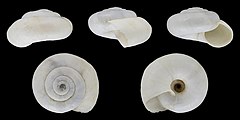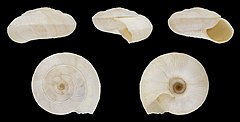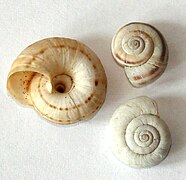Xerolenta obvia
| Xerolenta obvia | |
|---|---|

| |
| Scientific classification | |
| Domain: | Eukaryota |
| Kingdom: | Animalia |
| Phylum: | Mollusca |
| Class: | Gastropoda |
| Order: | Stylommatophora |
| Family: | Geomitridae |
| Subfamily: | Helicellinae |
| Tribe: | Helicopsini |
| Genus: | Xerolenta |
| Species: | X. obvia
|
| Binomial name | |
| Xerolenta obvia | |
| Synonyms | |
| |
Xerolenta obvia is a species of air-breathing land snail, a terrestrial gastropod mollusk in the family Geomitridae, the hairy snails and their allies.[2]
- Subspecies
- Xerolenta obvia depulsa (L. Pintér, 1969)
- Xerolenta obvia obvia (Menke, 1828)
- Xerolenta obvia pappi (Schütt, 1962)
- Xerolenta obvia razlogi (L. Pintér, 1969)
Distribution
[edit]
This land snail occurs in European countries[3] including Hungary, Bulgaria, Czech Republic, Italy, Poland, Slovakia, Ukraine,[4] Canada (Bethany, Ontario, Canada first detected in 1969 and 1972;[5] at least 23 occurrences in southern Ontario as of 2015[6]), United States of America (Wayne County, Michigan Detected in 2002 - B. Sullivan) and others.
This species in the USA is considered to represent a potentially serious threat as a pest, an invasive species which could negatively affect agriculture, natural ecosystems, human health or commerce. Therefore, it has been suggested that this species be given top national quarantine significance in the USA.[7]
Description
[edit]Shells of Xerolenta obvia are medium-sized (7–10 mm high, 14–20 mm wide) and relatively flat. In the adult stage, 5 to 6 turns are present. These shells are usually thick and smooth, with a white or yellowish-white basic color and quite variable, dark brown to almost black bands. The body is yellowish-brown.
Life cycle
[edit]The size of the egg is 1.5 mm.[8]
Gallery
[edit]-
Xerolenta obvia, banded form
-
Xerolenta obvia, white form
-
Xerolenta obvia, ribbed form
-
Xerolenta obvia pappi
-
Shells of Xerolenta obvia
-
Apical view of a shell of Xerolenta obvia
-
Umbilical view of a shell of Xerolenta obvia
References
[edit]- ^ Menke C.T. (1828). Synopsis methodica molluscorum generum omnium et specierum earum, quae in museo Menkeano adservantur; cum synonymia critica et novarum specierum diagnosibus. pp. I-XII [= 1-12], 1-91. Pyrmonti. (Gelpke).
- ^ MolluscaBase eds. (2022). MolluscaBase. Xerolenta obvia (Menke, 1828). Accessed through: World Register of Marine Species at: https://marinespecies.org/aphia.php?p=taxdetails&id=1003460 on 2022-08-03
- ^ Fauna europaea
- ^ Balashov I. & Gural-Sverlova N. 2012. An annotated checklist of the terrestrial molluscs of Ukraine. Journal of Conchology. 41 (1): 91-109.
- ^ Grimm, F. W. & Wiggins, G.B. ([1975]). Colonies of the European snail Helicella obvia (Hartmann) in Ontario. The Canadian Field-Naturalist 88 (4): 421–428.
- ^ Forsyth, R.G., M.J. Oldham, E. Snyder, F.W. Schueler & R. Layberry (2015). Forty years later: distribution of the introduced Heath Snail, Xerolenta obvia, in Ontario, Canada (Mollusca: Gastropoda: Hygromiidae). Check List 11(4): 1711. doi:10.15560/11.4.1711
- ^ Cowie R. H., Dillon R. T., Robinson D. G. & Smith J. W. (2009). Alien non-marine snails and slugs of priority quarantine importance in the United States: A preliminary risk assessment. American Malacological Bulletin 27: 113-132. PDF.
- ^ Heller J. (2001). Life History Strategies'.' in Barker G. M. (ed.): The biology of terrestrial molluscs. CABI Publishing, Oxon, UK, ISBN 0-85199-318-4. 1-146, cited page: 428.
- Westerlund, C. A. &. Blanc, H. (1879). Aperçu sur la faune malacologique de la Grèce inclus l'Epire et la Thessalie. Coquilles extramarines. 161 pp. + errata (1 pp.), pl. 1–4.
- Bank, R. A. (2011). Authorships and publication dates in malacology: some notes on the 2011 French Checklist of Welter-Schultes & al. Mitteilungen der Deutschen Malakozoologischen Gesellschaft. 86: 13–24. Frankfurt am Main
- Bank, R. A.; Neubert, E. (2017). Checklist of the land and freshwater Gastropoda of Europe. Last update: July 16, 2017
External links
[edit]- Clessin, S. (1879). Aus meiner Novitäten-Mappe. Malakozoologische Blätter. Neue Folge. 1: 3–16.
- Mousson, A. (1863). Coquilles terrestres et fluviatiles, recueillies dans l'Orient par M. le Dr. Alex. Schläfli. Vierteljahrsschrift der Naturforschenden Gesellschaft in Zürich. 8: 275-320, 368-426







